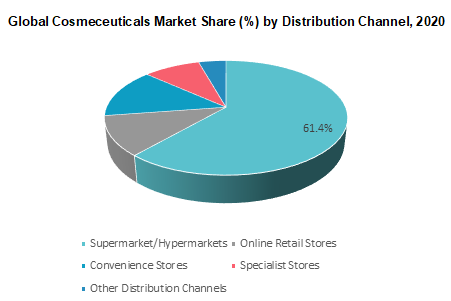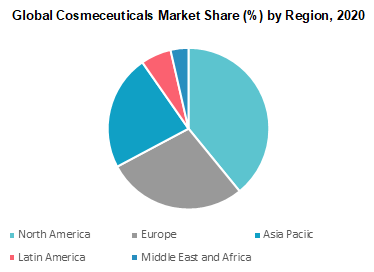The global Cosmeceuticals market is anticipated to increase at a 8.64% CAGR to reach value USD 95.09 Billion in 2030
.jpg)
Increasing demand for cosmeceuticals due to the growing aging population is one of the major factors that assist in driving the growth of the cosmeceuticals market. Furthermore, increasing the standard of living is another factor that promotes the growth of the market. However, the high cost of the products and the absence of awareness in African countries about cosmeceuticals are the factors are projected to hinder the growth of the market. Nonetheless, ongoing research and development following with untapped market the Asia Pacific in the region will bring the huge growth avenues during the forecasted period.
The cosmeceuticals market offers a wide range of products broadly categorized under skincare service, haircare, lip care, and oral care. Also, the market covers the products available across distribution channels supermarket/hypermarkets, convenience store software, online stores, specialty stores, others.
The term “cosmeceutical” was introduced by dermatologist Dr. Albert Kligman in 1984 and is derived from a combination of the words cosmetic and pharmaceutical. Cosmeceuticals refer to the combination of cosmetics. These are cosmetic products biologically dynamic fixing implying to have medical or drug-like advantages. But, Cosmetic Surgery includes surgical & nonsurgical procedures that reshape the typical structure of the body in order to improve appearance and self-esteem also.
Since the outbreak of Covid-19 in March 2020, the market of global cosmeceuticals products has shown to decline. Due to the rigid lockdown of various countries and disturbance in the supply chain-like situation going on across the globe cosmetic manufacturers had to shut down their production units. Furthermore, the production unit faces heavy losses due to labor shortages. However, as the situation is getting improved globally, the market is set to revive and the sales are expected to recover in the coming years.
Moreover, the leading companies are eyeing online distribution as an opportunistic segment of the market as retail stores are predicted to have lesser consumer visits till the pandemic ends. Thus, skincare brands such as Olay have partnered with Shope for a new digital campaign targeted at the millennial consumer demographic as part of its strategic e-commerce growth plans for southeast Asia.
Major current market players include L'Oreal SA, Procter & Gamble, Unilever PLC, Shiseido Co. Ltd, Revlon Inc., Groupe Clarins SA, Beiersdorf AG, Johnson & Johnson Inc., and Others
Cosmeceuticals Market Scope
| Metrics | Details |
| Base Year | 2023 |
| Historic Data | 2018-2022 |
| Forecast Period | 2024-2030 |
| Study Period | 2018-2030 |
| Forecast Unit | Value (USD) |
| Revenue forecast in 2030 | USD 95.09 Billion |
| Growth Rate | CAGR of 8.64% during 2020-2030 |
| Segment Covered | By Product, By Distribution Channel, Regions |
| Regions Covered | North America, Europe, Asia Pacific, South America, Middle East and Africa |
| Key Players Profiled | Johnson & Johnson, Procter & Gamble, Sabinsa Corporation, L’Oréal, Allergan, AVON, Estee Lauder, Unilever, Beiersdorf, and Croda International Plc. |
Segment Overview of Global Cosmeceuticals Market
Type Overview (USD Billion)
- Skin Care
- Anti-ageing
- Anti-acne
- Sun Protection
- Moisturizers
- Other Skin Care Product Types
- Hair Care
- Shampoos and Conditioners
- Hair Colorants and Dyes
- Other Hair Care Product Types
- Lip Care
- Oral Care
Distribution Channel Overview, (USD Billion)
- Supermarket/Hypermarkets
- Online Retail Stores
- Convenience Stores
- Specialist Stores
- Other Distribution Channels
Regional Overview, (USD Billion)
- North America
- U.S.
- Canada
- Europe
- UK
- Germany
- France
- Rest of Europe
- Asia Pacific
- China
- India
- Japan
- Rest of Asia Pacific
- Middle East and Africa
- South Africa
- UAE
- Rest of Middle East and Africa
- South America
- Brazil
- Rest of South America
Reasons for the study
- The purpose of the study is to give an exhaustive outlook of the global Cosmeceuticals industry
- The overall segmentation of Cosmeceuticals market, especially key segments are thoroughly studied.
- Presence of major players and their wide product portfolio across developed countries is anticipated to further boost the growth of Cosmeceuticals market
What does the report include?
- The study on the global Cosmeceuticals market includes analysis of qualitative market indicators such as drivers, restraints, challenges, and opportunities
- Additionally, the market competition has been evaluated using the Porter’s five forces analysis
- The study covers qualitative and quantitative analysis of the market segmented on the basis of type, distribution channel and country. Moreover, the study provides similar information for the key geographies.
- Actual market sizes and forecasts have been provided for all the considered segments
- The study includes the profiles of key players in the market with a significant global and/or regional presence
Who should buy this report?
- The report on the global Cosmeceuticals market is suitable for all the players across the value chain including raw material suppliers, producer, distributors, suppliers, and retailers
- Venture capitalists and investors looking for more information on the future outlook of the global Cosmeceuticals market
- Consultants, analysts, researchers, and academicians looking for insights shaping the global Cosmeceuticals marke
Frequently Asked Questions (FAQ) :
The global cosmeceuticals market is expected to grow at a CAGR of 8.8% over the forecast period. The global cosmeceuticals market is highly fragmented in nature as large number of small cosmeceuticals manufacturer companies are operating in this global industry. Manufacturers are adopting mergers & acquisitions and new product development strategies to increase their geographical reach. Additionally, well-established Chinese manufacturing companies are focusing on untapped areas to increase their market concentration. For instance,
- In May 2018, L’Oreal acquired Nanda, the Korean lifestyle, make-up, and fashion company. Nanda has expanded its business into overseas markets, including Hong Kong, Singapore, Malaysia, and Thailand
Based on the type, the cosmeceuticals market has been segmented into skin care, hair care, lip care, and oral care. The skincare segment is projected to lead the cosmeceuticals market during the forecast period. The skincare market is further classified into Anti-ageing, Anti-acne, Sun Protection, Moisturizers, and Other Skin Care. Due to the increasing aging population, Anti-aging captured a large market share in the year 2020. Rising standard of living following by increasing self-awareness is the major driving factor that promotes the growth of the market.
Based on the Distribution channel, the cosmeceuticals market has been segmented into supermarket/hypermarkets, online retail stores, convenience stores, specialist stores, and other distribution channels. The supermarket/hypermarkets segment is estimated to lead the cosmeceuticals market from 2018 to 2028. The distribution channel plays a major role in increasing the sales of the product. Large discounts availability is also the major driving factor for the segment. The number of people visiting the supermarket is comparatively larger than compared to another segment.

The cosmeceuticals market is classified into five major regions, North America, Europe, Asia Pacific, Latin America and the Middle East, and Africa. The term ‘cosmeceuticals’ was first used in China, and now it has become common across the world. Environmental populations following with aging population are considered one of the major driving factors across the world. Growing skin disorder in the countries like China and India in the Asia Pacific region is the most driving factor that promotes the growth of the market. Moreover, Japan and South Korea are the most attractive countries for the region. Increasing Japanese and south Korean brand across the world is also one of the major factors which promotes the growth of the market.
The recent COVID-19 pandemic is expected to impact the global cosmeceuticals industry. The entire supply chain is disrupted due to a limited supply of raw materials. Chinese suppliers around the globe have placed production lines on halt or shut them down completely. Such disruptions in the supply chain are expected to affect the production of the final product in Europe and North America.


